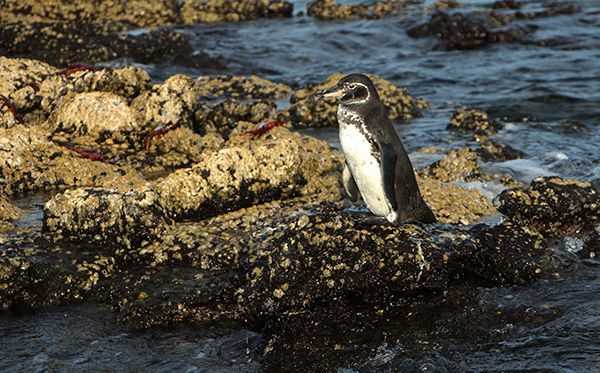By 6:30 in the morning, the sun was out and we were ready for the first outing of the day. This small island is known for its truly fantastic volcanic landscape, which reminds some visitors of the moon.
About 400 wooden steps make up the boardwalk build by the national park some years ago, to protect the island from erosion and to help people get to the top of the island. From the summit, we enjoyed an outstanding view of the surroundings as well as some other islands in the vicinity. Very few animals are found here, as the land is dominated by rocks and the soil is not as productive from lack of humidity. Some lava lizards have become adapted to the area, as have the Darwin’s finches and Galapagos doves. The conditions here are not very supportive of vegetation, and the ones that do live here are so well-adapted that they deserve a mention, especially the Galapagos lava cactus, a pioneer on the lava.
After this early outing, we come back onboard for breakfast, and also to get ready for the next activity of the day, which was snorkeling. A wet landing on pink sand was the beginning of our water exploration, with many chances to see fish, sharks, rays, turtles, sea stars, and the most playful animals of the Galapagos, the sea lions. Snorkeling with penguins along the equator is unexpected but incredible, and we were fortunate enough to have this opportunity. Hundreds of sea stars dotted the sea walls, like constellations in a clear sky.
Our next destination was an island that looks very much like a Chinese hat, from where its name derives. We began the afternoon with a deep-water snorkeling session along the coast of Santiago just in front of Chinese hat. There are some many different types of large and small colorful fish here. Large white-tipped reefs sharks could be seen lying on the ocean floor, and the always-friendly sea lions came to entertain the snorkelers with their amazing charm and aquatic acrobatics.
Penguins also live here. They nest here in these islands and have adapted to live in an environment quite different to the one they came from. We met some in the water, which stayed very close to us for some time before swimming away to chase some fish. Others were standing on the rocks, almost still, as we snorkeled underneath their feet. Later on, we came back to this spot to take pictures of them on the rocks. There were many of them resting on the coastline, and not too far from them were other animals, especially sea lions, darting playfully through the waves. It was another great day in the Galapagos!







